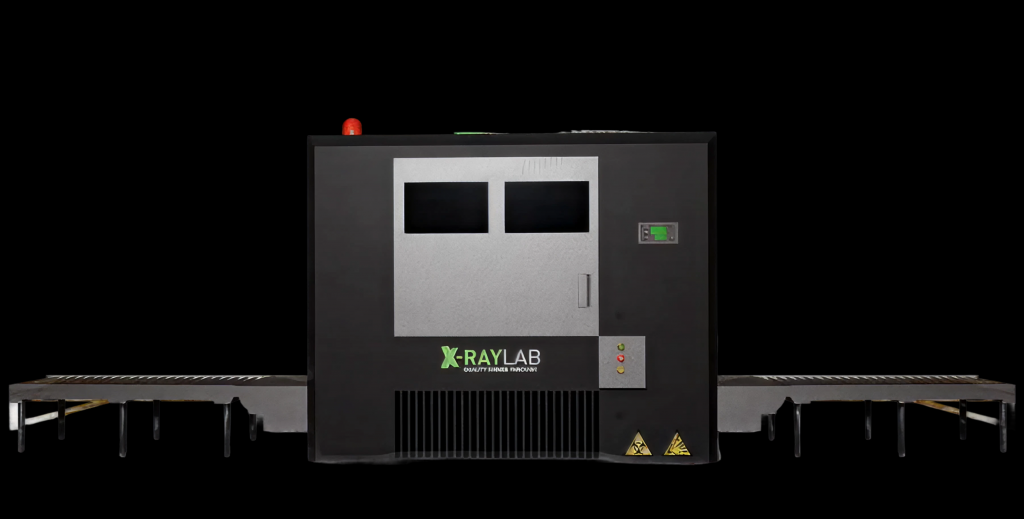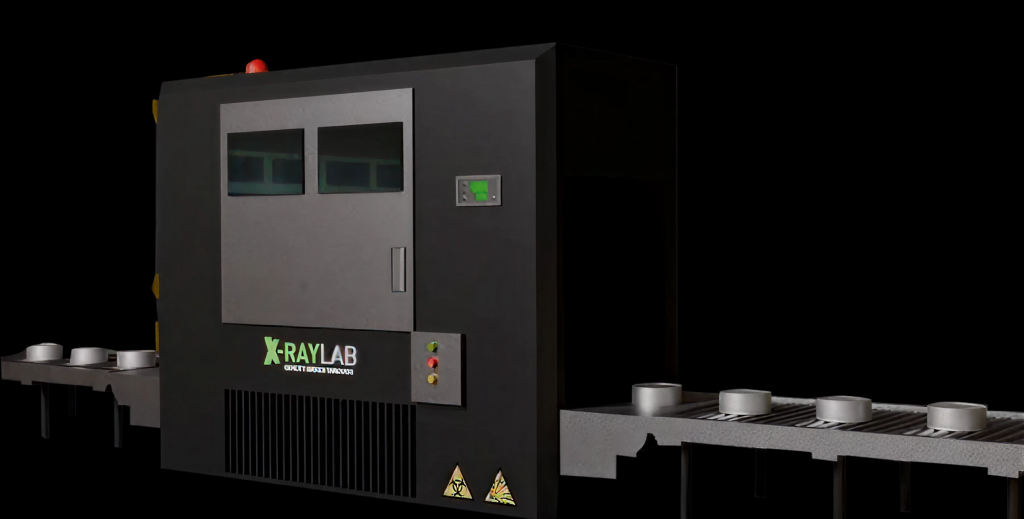Introduction
Modern manufacturing is evolving at a rapid pace. Speed, precision, and automation are no longer optional, they are essential for staying competitive. Yet, traditional quality control methods, where parts are manually pulled from the line for inspection, are increasingly inefficient.
They slow down production, create bottlenecks, and often catch problems too late. Today’s manufacturers need smarter, faster inspection tools that can keep up with the production flow.
This is where inline CT (Computed Tomography) scanning comes in. By integrating 3D X-ray inspection directly into the production line, inline CT delivers real-time defect detection, reduces waste, and ensures every single component meets strict quality standards—without halting production.
Table of Contents

Xray-Lab Inline CT system — delivering high-speed, real-time 3D inspection.
What Is Inline CT?
Inline CT is a 3D X-ray inspection system designed specifically for the factory floor.
Instead of operating like lab-based CT scanners—which are slow, manually configured, and better suited for research—inline CT is built for high-speed manufacturing environments.
Here’s how it works:
- An X-ray source and detector capture multiple images of a part as it moves through the line.
- Advanced software instantly reconstructs those images into a 3D model.
- The system automatically scans for hidden defects such as cracks, porosity, voids, or dimensional inaccuracies.
This means manufacturers can achieve full internal inspection of every component—in real time—without slowing production.
Why Inline CT Matters for Manufacturers
Inline CT is more than a machine—it’s a strategic enabler for manufacturers who need to maintain quality, speed, and competitiveness simultaneously.
Here’s why it matters:
- Non-Stop Quality Control
Traditional quality checks often rely on random sampling, meaning only a fraction of the produced parts are inspected. This leaves room for hidden issues to slip downstream, leading to recalls, warranty claims, and damaged customer trust.
With inline CT, every single component is checked in real time without stopping the production line. This enables 100% quality assurance while maintaining throughput.
For industries like automotive, aerospace, and electronics, where even a minor defect can trigger costly consequences, continuous verification ensures that only parts meeting the highest standards move forward.
- Early Defect Detection
Catching problems late in the process often means expensive rework, wasted materials, and delayed deliveries. For example, discovering porosity in a casting after machining has already been completed can translate into significant scrap costs.
Inline CT changes the game by detecting defects immediately, as the part is being made. Whether it’s internal voids, cracks, incorrect assembly, or dimensional deviations, issues can be flagged before they impact downstream processes.
This not only reduces waste but also minimizes production bottlenecks and helps teams take corrective action right away—cutting costs and increasing reliability.
- Seamless Automation
One of the biggest strengths of inline CT systems is their ability to connect directly with factory automation platforms like MES (Manufacturing Execution Systems) and PLCs (Programmable Logic Controllers).
In practice, this means the inspection process doesn’t just collect data—it actively drives decision-making. If a defective part is identified, it can be:
- Automatically removed from the line,
- Tagged for review, or
- Redirected to a rework path.
This all happens without interrupting production.
Beyond rejection, the feedback loop ensures upstream equipment—such as molding, casting, or welding machines—can adjust in real time based on inspection results. This creates a truly self-correcting production system, which is essential in lights-out or fully automated factories.
- Data for Smart Manufacturing
Inline CT is not just about checking parts—it’s also a data powerhouse. Every inspection generates detailed 3D data that can be stored, analyzed, and fed back into design, engineering, and production.
Manufacturers can use this data to:
- Improve designs by identifying recurring weak points,
- Optimize processes by analyzing defect patterns across shifts, batches, or materials,
- Enable predictive maintenance by spotting subtle changes before machines fail, and
- Support compliance by automatically archiving inspection data for quality audits.
This shift from inspection to data-driven intelligence makes inline CT a central tool in Industry 4.0 strategies. Over time, the system doesn’t just check quality—it actively helps make your production smarter and more resilient.
Configurations to Fit Every Line
One of the strengths of inline CT is its flexibility. Different configurations can be tailored to production needs:
- Portal-based systems – Fast and efficient, ideal for high-volume production of small to mid-sized parts.
- Gantry-based systems – Perfect for scanning larger or more delicate components that require stable handling.
- Robotic-based systems – Highly flexible, allowing programmable inspections of parts with complex or irregular geometries.
Each configuration has trade-offs, but all share the same outcome: reliable 3D X-ray inspection integrated directly into your production environment.
The Key Benefits at a Glance
- 100% Inline Inspection Without Slowing Production
Instead of pulling random samples off the line, every part can be inspected in the flow of production. This ensures that no hidden defects slip through, while throughput remains unaffected. In industries where speed is critical—like electronics or automotive—this balance of efficiency and thoroughness is a huge win. - Reduced Scrap and Rework Through Instant Detection
By catching problems immediately, parts that would otherwise become waste are addressed early. For example, if porosity is detected in a metal casting before machining begins, the cost of wasted machining hours is avoided. This not only lowers material losses and rework costs but also saves time and resources that can be redirected to productive work. - Improved Product Reliability and Customer Confidence
A part that passes inline CT is not just “good enough”—it has been verified inside and out. This level of quality assurance builds trust with customers and reduces the chances of costly recalls or warranty claims. For safety-critical sectors like aerospace and medical devices, this benefit directly translates into brand reputation and long-term reliability. - Seamless Integration with Automated Workflows
Inline CT doesn’t operate in isolation. It integrates with robotic systems, conveyors, MES, and PLCs, making it part of a smart workflow. Defective parts can be automatically separated, tagged, or assigned for rework without human intervention. This not only improves consistency but also enables lights-out manufacturing setups where inspection and correction are fully automated. - Data-Driven Insights for Smarter Decisions
Every CT scan generates detailed 3D data that can be stored and analyzed for long-term insights. Over time, this data can help spot trends—for example, recurring defects tied to a specific mold, supplier batch, or machine setting. Manufacturers gain more than just defect detection—they build a knowledge base for continuous improvement, predictive maintenance, and even product innovation
Conclusion
Inline CT scanning transforms quality control from a slow, manual checkpoint into a real-time, automated, and intelligent assurance process.
By moving inspection directly into the production line, manufacturers gain faster feedback loops, lower costs, reduced waste, and improved product reliability—all without sacrificing production speed.
Xray-Lab provides tailored Inline CT Scanning solutions designed to meet the needs of modern, automated factories. With expertise in non-destructive testing, Xray-Lab helps manufacturers maintain consistently high quality, reduce risks, and unlock the full potential of smart manufacturing.

High-precision Inline CT Machine by XRAYLAB – enabling real-time, automated inspection of products on the conveyor for unmatched quality assurance.
Frequently Asked Questions
What exactly is Inline CT and how does it differ from traditional CT
In contrast to typical offline CT, which necessitates manual human handling and separate scanning, Inline CT incorporates 3D Xray inspection straight into the production line, providing real time, non-destructive imaging.
What types of components are suited for Inline CT inspection?
Light metals, composites, ceramics, and polymers are the finest materials for inline CT. Steel and other dense materials could need greater X-ray energy and different scan configurations.
How long does an Inline CT scan typically take?
Scan duration depends on factors such as resolution, material density, and part size. Inline CT systems are designed to align with production cycle times and can often complete scans in under 60 seconds.
Can multiple parts be scanned at once using Inline CT?
If the parts fit inside the scanner’s volume, batch scanning is feasible. Although throughput is increased, part placement and material variations may affect precision.
How is Inline CT integrated with factory automation systems?
Through the use of common protocols (such OPC UA), inline CT systems may interact with PLCs and MES platforms, allowing for real-time production parameter modifications and the automatic sorting of defective parts.

